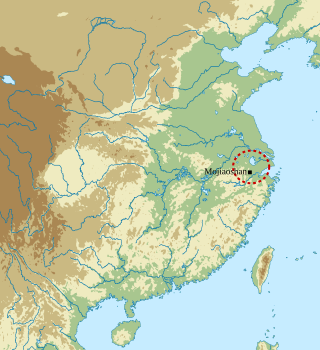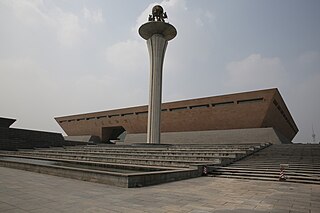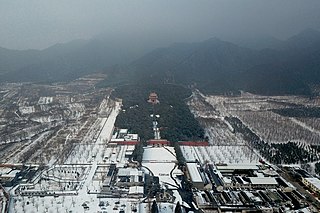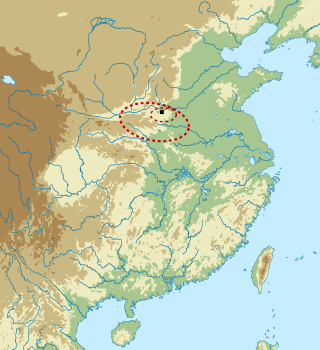
The Shanghai Museum is a municipal public museum of ancient Chinese art, situated on the People's Square in the Huangpu District of Shanghai, China. It is funded by the Shanghai Municipal Culture and Tourism Bureau.

Yinxu is the site of one of the ancient and major historical capitals of China. It is the source of the archeological discovery of oracle bones and oracle bone script, which resulted in the identification of the earliest known Chinese writing. The archeological remnants known as Yinxu represent the ancient city of Yin, the last capital of China's Shang dynasty which existed through eight generations for 255 years, and through the reign of 12 kings. Yinxu was discovered, or rediscovered, in 1899. It is now one of China's oldest and largest archeological sites, and was selected as a UNESCO World Heritage Site in 2006. Yinxu is located in northernmost Henan province near the modern city of Anyang, and near the Hebei and Shanxi province borders. Public access to the site is permitted.

The Liangzhuculture or civilization was the last Chinese Neolithic jade culture in the Yangtze River Delta. The culture was highly stratified, as jade, silk, ivory and lacquer artifacts were found exclusively in elite burials, while pottery was more commonly found in the burial plots of poorer individuals. This division of class indicates that the Liangzhu period was an early state, symbolized by the clear distinction drawn between social classes in funeral structures. A pan-regional urban center had emerged at the Liangzhu site in northwestern Hangzhou, Zhejiang, and elite groups from this site presided over the local centers. The Liangzhu culture was extremely influential and its sphere of influence reached as far north as Shanxi and as far south as Guangdong. The primary Liangzhu site was perhaps among the oldest Neolithic sites in East Asia that would be considered a state society. The type site at Liangzhu was discovered in Yuhang County, Zhejiang and initially excavated by Shi Xingeng in 1936.
Archaeology is the study of human activity in the past, primarily through the recovery and analysis of the material culture and environmental data that they have left behind, which includes artifacts, architecture, biofacts and cultural landscapes.

Songjiang is a suburban district of Shanghai. It has a land area of 605.64 km2 (233.84 sq mi) and a population of 1,582,398 (2010). Owing to a long history, Songjiang is known as the cultural root of Shanghai.

The Majiabang culture, formerly also written Ma-chia-pang, was a Chinese Neolithic culture that occupied the Yangtze River Delta, primarily around Lake Tai west of modern Shanghai and north of Hangzhou Bay. The culture spread throughout southern Jiangsu and Zhejiang north of Hangzhou Bay from around 5000 BC to 3300 BC, coexisting with the Hemudu culture in Zhejiang south of the bay. The later part of the period is now considered a separate cultural phase, referred to as the Songze culture. The Majiabang and Songze cultures were succeeded in their area by the Liangzhu culture.

The Tomb of Fu Hao is an archaeological site at Yinxu, the ruins of the ancient Shang dynasty capital Yin, within the modern city of Anyang in Henan Province, China. Discovered in 1976 by Zheng Zhenxiang, it was identified as the final resting place of the queen and military general Fu Hao, who died about 1200 BCE and was likely the Lady Hao inscribed on oracle bones by king Wu Ding and one of his many wives.

The Shijiahe culture was a late Neolithic culture centered on the middle Yangtze River region in Shijiahe Town, Tianmen, Hubei Province, China. It succeeded the Qujialing culture in the same region and inherited its unique artefact of painted spindle whorls. Pottery figurines and distinct jade worked with advanced techniques were also common to the culture.

During the Ming dynasty (1368–1644), Chinese painting progressed further basing on the achievements in painted art during the earlier Song dynasty and Yuan dynasty. The painting techniques which were invented and developed before the Ming period became classical during this period. More colours were used in painting during the Ming dynasty. Seal brown became much more widely used, and even over-used during this period. Many new painting skills/techniques were innovated and developed, calligraphy was much more closely and perfectly combined with the art of painting. Chinese painting reached another climax in the mid and late Ming. The painting was derived in a broad scale, many new schools were born, and many outstanding masters emerged.
Since the second half of the 20th century, inscriptions have been found on pottery in a variety of locations in China, such as Banpo near Xi'an, as well as on bone and bone marrows at Hualouzi, Chang'an County near Xi'an. These simple, often geometric, marks have been frequently compared to some of the earliest known Chinese characters appearing on the oracle bones, and some have taken them to mean that the history of Chinese writing extends back over six millennia. However, only isolated instances of these symbols have been found, and they show no indication of representing speech or of the non-pictorial processes that a writing system requires.

Luoyang Museum is a historical museum in Luoyang, Henan Province, China. Situated in the Yellow River valley. It offers exhibits of the rich cultural heritage of Luoyang, a major Chinese cultural centre, which was the capital of numerous Chinese dynasties including the Eastern Zhou and the Eastern Han.

Chinese archaeology has been practiced since the Song dynasty (960-1279) with early practices of antiquarianism. Although native Chinese antiquarianism developed some rigorous methods of unearthing, studying, and cataloging ancient artifacts, the field of archaeology in China never developed into a branch of study outside of Chinese historiography. Native Chinese antiquarian studies waned after the Song period but were revived during the Qing dynasty (1644-1912). Rigorous standards of modern Chinese archaeology were first developed at the turn of the 20th century by Chinese archaeologists educated in the West and in the early Republic of China (1912–1949).

The Songze Culture was a Neolithic culture that existed between 3800 and 3300 BCE in the Lake Tai area near Shanghai.

The Ming Dingling is a mausoleum in China where the Wanli Emperor, together with his two empresses Wang Xijie and Dowager Xiaojing, was buried. Dingling is one of the thirteen imperial tombs at Ming tombs in Changping district 45 km north of central Beijing. The Dingling is the only tomb of a Ming dynasty emperor that has been excavated since the founding of the People's Republic of China, a situation that is almost a direct result of the fate that befell Dingling and its contents after the excavation.

The Tianfei Palace, officially the Mazu Cultural Palace and also known as the Tianhou Palace, is a restored temple of the Chinese sea-goddess Mazu, the deified form of the medieval Fujianese shamaness Lin Moniang, located in Fangta Park in Songjiang, Shanghai, in eastern China. Officially classified as a museum, the Tianfei Palace conducts Mazuist rites twice a year, on the traditional anniversaries of Lin Moniang's birth and death. It is also used as the site for an annual commemoration of Songjiang's city god Li Daiwen.

In 2001, the Institute of Archaeology of the Chinese Academy of Social Sciences organized a poll for China's 100 major archaeological discoveries in the 20th century. The participants included eight national-level institutions for archaeology and cultural relics, provincial-level archaeological institutes from 28 provinces, municipalities, and autonomous regions, as well as from Hong Kong, the archaeological departments of 11 major national universities, and many other scholars in Beijing. After three months and three rounds of voting, the results were announced on 29 March 2001 and were published in the journal Kaogu (Archaeology). In 2002, the Chinese Academy of Social Sciences Press published the book China's 100 Major Archaeological Discoveries in the 20th Century (二十世纪中国百项考古大发现), with more than 500 pages and 1,512 pictures.
Zhang Changshou was a Chinese archaeologist who served as vice director of the Institute of Archaeology, Chinese Academy of Social Sciences (CASS). He was a corresponding member of the German Archaeological Institute and an honorary member of the CASS.

Chen Zilong was a Chinese poet, essayist and official active during the late Ming dynasty and early Qing dynasty.















